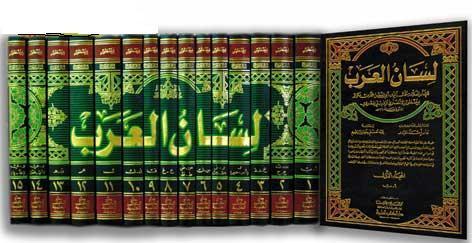
A Modern printing of the Lisan al-`Arab ...
The Mystic Knower and the Learned Grammarian of the Haft Vadi, the `Valley of Search' of Mirza Husayn `Ali Nuri, Bahā'-Allāh (1817-1892).
Stephen N. Lambden UCMerced.
In progress and correction - last updated 19-04-2017.
Towards the end of the first valley of search (talab) of the Haft vadi (Seven Valleys) the following passage about a mystic knower (`ārif-i ilāhi) and his journey with a learned grammarian (`alim-i nahwi) is found :
The story is told of a mystic knower (`ārif-i ilāhi), who went on a journey with a learned grammarian (`alim-i nahwi) as his companion. They came to the shore of the Sea of Grandeur (sha`ti bahr al-`azimat). The knower ( `arif) straightway flung himself into the waves, but the grammarian (`alim-i nahwi) stood lost in his reasonings, which were as words that are written on water. The knower called out to him "Why dost thou not follow?" The grammarian answered, "O Brother. I dare not advance. I must needs go back again."
Then the knower cried, "Forget what thou didst read in the books of Sibâvayh and Qawlavayh, of Ibn-i-Hājib and Ibn-i-Mālik and cross the water." The death of self is needed here, not rhetoric: Be nothing, then and walk upon the waves.
Likewise is it written.
־־And be ye not like those who forget God. and whom He hath therefore caused to forget their own selves. These are the wicked doers" ( = Q. 59:19). ...
Some brief Notes of Commentary.
The lines from the Haft Vadi cited above relate the story of the `ārif or mystic knower, one aware of matters divine and the learned grammarian (`alim-i nahwi), one expert in matters of grammar and syntax. The former is exhorted to bypass the intricacies of matters like Arabic grammar in the heartfelt quest for the spiritual Beloved. It seems that proponents of grammatical learning had become archetypal or symbolic of the concern with the intricacies of the worldy things.Though intellectually necessary, the study of books of Arabic grammar, worldly things, can be a complex and time consuming subject. It may be a distraction from spiritual attainment or insight. Grammatical erudition may be a distraction from spiritual attainment.
Baha'-Allah does not say anything negative about Arabic grammar itself or its major exponents and commentators, four of whom he lists in their abbreviated Persianized names. Two were Persian born, the Sunni Sibawayh (born Shiraz) and the Shi`i Ibn Qulawayh (born Qum). The other two were erudite 13th century CE Sunni Muslims; Ibn-i-Ḥājib was an Egyptian, and Ibn Mālik was born in Spain (for detals see below). Baha-Allah may well have been encouraged to study such works while a young man. The study of Arabic grammar books was part of general and clerical education in Qajar Iran. Persons who aspired to the office of the `ulama or the mujtahid had to study and show some familiarity or expertise with certain of these fundamental Arabic grammars. The Qur'an is in Arabic as is the vast heritage of Islamic learning. A knowledge of Arabic was thus an essential part of Islamic education. Such grammatical knowledge, however, was not fundamental for most seekers on the mystic quest. The mystic knower could proceed on the path while the erudite Arabist was as one hesitant or lost.
The didactic story of contrast or differing stance of the `arif as one deeply awarem, and the `alim consumed with grammatical studies, proffers a lesson. It is the kind of figurative tale found in numerous world literatures. In the Islamic world this story ....
ADD HERE.
The following notes will attempt to give a brief biography and overview of the key grammatical and other writings of the four persons listed by Baha'-Allah in this part of his Haft Vadi (Seven Valleys).
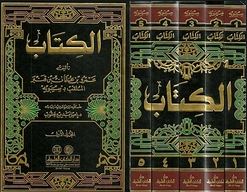

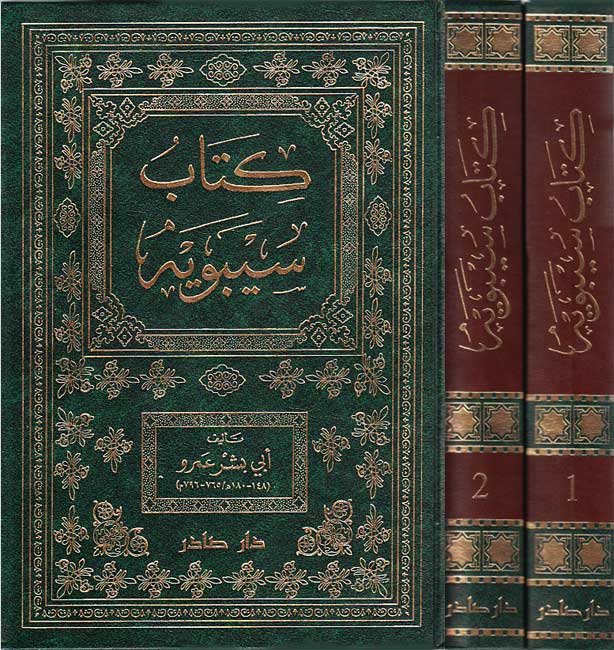
A Modern edition of the al-Kitab of Sībawayh and the 2 vol. Beirut Dar Sadir printing in 946 pp.
[1] Sībawayh [Sibâvayh] (b. Bayda near Shiraz or Hamadan [Persia] c. XXX/750- d. Shiraz [Persia], c. 177/793)
= أبو بشر عمرو بن عثمان بن قنبر البصري
Abū Bishr ʿAmr ibn ʿUthmān ibn Qanbar al-Baṣrī was known (in Arabic transliteration) as سيبويه Sībawayh after his Persian name سیبویه Sēbōē perhaps meaning or suggestive of an apple, meaning something like the "scent of an apple (= Per. sīb ) perhaps on account of the allegedly scented breath of Sībawayh. Though having a Persian name and lineage, Sībawayh was among the earliest Muslims to write a comprehensive Arabic grammar which came to have the title الكتاب al-Kitab, "The Book". Little is known of his life though it has been expertl;y summed up in the following manner, "His father had not been a Muslim and when he converted to Islam he became a client of the Arab tribe of the Banû l-Hârith ibn Ka‘b. His mother tongue was Persian and he never completely lost his Persian accent in Arabic. On arriving in Basra his original intention was to study Islamic law, but when he was ridiculed by some people for the grammatical mistakes he made he decided to study grammar instead" (Versteegh, 1997: 29). His most important teachers, whom he frequently cites, included :
- al-Khalīl ibn Aḥmad ibn ʿAmr ibn Tamīm al-Farāhīdī al-Azdī al-Yaḥmadī al-Baṣrī Abū ʿAbd al-Raḥmān (b. ʿUmān, lived and died in Baṣra in 175/791, or 170/786, or 160/776 (so Arik Sadan: 2012: 345).
- ʿAbd-Allāh ibn Abī Isḥāq,
- ʿĪsā b. ʿUmar al-Ṯaqafī (active in Baṣra where he died in 149/766),
- Abū ʿAmr ibn al-ʿAlāʾ,
- Hārūn al-Qāriʾ,
- Abū l-Khaṭṭāb al-Akhfash and
- Yūnus ibn Ḥabīb
(see further Sadan: 2012 esp. App. B p. 319ff).
There is an excellent section on `Sîbawayhi and the beginnings of Arabic grammar' in the important 1997 book of Kees Versteegh (currently Professor of Arabic and Islam at the Middle East Institute of the University of Nijmegen, the Netherlands) entitled, `The Arabic linguistic tradition' (see pp. 27-38) within the Routledge series `Landmarks in Linguistic Thought III: The Arabic Linguistic Tradition. This series is devoted to the main linguistic tradition of the Middle East, namely that of Arabic linguistics'. Within this chapter the importance of "The Book" and person of Sîbawayhi are referred to in the following manner :
"the most famous book in the Arabic linguistic tradition, known as the Kitâb Sîbawayhi, the “Book of Sîbawayhi”. Its place in the Arabic linguistic tradition is unrivalled, and the respect it has gained in this tradition is demonstrated by the name it received from one biographer, who called it Qur’ân an-nahw “the Qur’ân of grammar”, just as Sîbawayhi was sometimes called ’imâm an-nuhât “the imâm of the grammarians”. Without exaggeration one could say that the entire linguistic tradition in Arabic is nothing but a huge commentary on the Kitâb Sîbawayhi. In this respect the Sanskrit and the Arabic tradition resemble each other: at the beginning of both traditions stands an almost mythical figure whose work dominates the entire tradition.
Later biographers mention as many as six or seven teachers of Sîbawayhi. The problem is that they wished his biography to conform to the model of later biographies, which obligatorily contained a paragraph about a grammarian’s teachers. Accordingly, every grammarian mentioned by Sîbawayhi in his Kitâb was elevated to the rank of teacher. If we go by the quotations in the text, of which there are hundreds, we would have to say that al-Khalîl ibn ’Ahmad , ... whom he quotes by far the most frequently, was his principal teacher. The phrasing of some of these quotations implies that he was personally in touch with al-Khalîl and often asked him for his opinion about grammatical problems. He must have met other grammarians, since he quotes their opinions in the Kitâb, but it is not clear in how far these were really his teachers...
Sîbawayhi’s Kitâb remained the authority for all later grammarians, many of whom wrote commentaries on its text, for instance as-Sîrâfî. For some time it also remained the model for the order in which many grammatical writings treated their material: syntax, morphology, phonology. The arrangement in itself was not regarded as sacrosanct, and in the course of the centuries several changes were introduced. One of Sîbawayhi’s immediate successors, al-Mâzinî (d. 863), wrote a treatise exclusively about morphology, and this new trend was followed by other authors. In the ninth/tenth centuries grammarians began to write shorter introductions to linguistics that were explicitly meant for beginning students. Such works as, for instance, az-Zajjâjî’s very popular Kitâb al-jumal and Ibn Jinnî’s Kitâb al-luma‘ contain a minimum of controversial issues and limit themselves to a straightforward treatment of the basic rules of grammar. Probably for didactic reasons, too, the grammarian az-Zamakhsharî (d. 1144) introduced an entirely new arrangement of the grammatical material in his Kitâb al-mufassal: after a section on the basic notions of grammar he divides his book into three sections, each of which is dedicated to the functions of one declensional case (nominative, accusative, genitive)... What must be pointed out is the fundamental unity of Arabic linguistic theory: after seven or eight centuries grammarians continued to quote Sîbawayhi’s Kitâb as an authoritative source and even when they disagreed with him, they tried to preserve as much as possible the way he formulated solutions to grammatical problems." (Versteegh, 1997: 29, 38).
Sībawayhi, 'Abū Bisjr `Amr ibn 'Uthmān ibn Qanbar (d. 177/793) : Primary sources and select Bibliography.
- Kitāb: Sībawayhi, Abū Bišr ʿAmr b. ʿUthmān. Le livre de Sībawaihi, Traité de grammaire arabe. Texte arabe publié par Hartwig Derenbourg. Paris: Imprimerie Nationale, 1881–1889. 2 vols.
- Kitāb Sībawayhi, Abū Bišr ʿAmr b. ʿUṯmān. Kitāb Sībawayhi, wabihāmišihi taqrīrāt wazubad min šarḥ Abī Saʿīd al-Sīrāfī wabiʾasfal al-ṣaḥīfa bil-qāʿida l-ṣaġīra sharḥ al-shawāhid al-musammā taḥṣīl ʿayn al-dhahab min maʿdin jawhar al-ʾadab fī ʿilm majāzāt al-ʿarab. Cairo: Maṭbaʿat Būlāq, 1316–1317/1898–1900. 2 vols.
- Le livre de Sībawaihi. Traité de grammaire arabe. ed. Hartwig Derenbourg, 2 vols. Paris: XXXX, 1881–1889.
- al-Kitāb. Kitāb Sībawayhi. ed. 'Abd al-Salām Hārūn, 5 vols. Cairo: XXXX, 1977.
- al-Sharh. Kitāb Sībawayhi. 6 vols., Cairo: XXXX 1988–2004.
- al-Ta'līqa 'alā Kitāb Sībawayhi. 'Iwad ibn Hamad al-Qūzī, ed. Cairo: XXXX 1410/1990.
Levin, Aryeh
- “Sībawayhi”. In: Auroux, S. et al. (eds.). History of the language sciences I. Berlin-New York: Walter de Gruyter, 2000, pp. 252–263.
- Sībawayhi’s attitude to the language of the Qurʾān” In: Arazi, Albert et al. (eds.). Israel Oriental Studies XIX (1999). Compilation and creation in adab and luġa: Studies in memory of Naphtali Kinberg (1948–1997). Winona Lake, Indiana: Eisenbrauns. pp. 267–272.
- “Sībawayhi’s attitude to the spoken language”, in Jerusalem Studies in Arabic and Islam XVII (1994). The Hebrew University of Jerusalem: Institute of Asian and African Studies. pp. 204–243.
Versteegh, Kees.
- 1997.`Sîbawayhi and the beginnings of Arabic grammar' (= ch. 3 pp. 27-38) in `The Arabic linguistic tradition' . Routledge : London, New York, 1997. This volume contains extracts of al-Kitab in translation.
Sadan, Arik.
- 2012. The Subjunctive Mood in Arabic Grammatical Thought. Leiden, Boston : Brill, 2012
♦
[2] Qawlavayh = Ibn Qawlawayh/ Qūlawayh (d. 367-9/978-9).

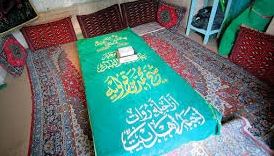
A modern edition of the Arabic کامل الزیارات Kamil al-ziyara of Ibn Qawlawayh al-Qumi and an image of his tomb.
[2] Ibn Qawlawayh or (more probably?) Qūlawayh or Qūlūya - ابن قولويه
= جَعفَر بن مُحَمَّد بن جَعفَر بن مُوسى بن مَسرور بن قُولَوَيه القُمّي
Abū l-Qāsim Ja'far ibn Muhammad ibn Ja'far ibn Mūsā ibn Masrūr ibn Qūlawayh [Qawlawayh] al-Qummī (b. Qum, c. XXX/XXX - d. Baghdad c. 367-8/978-9, ultimately buried Kazimayn). His father was named Muhammad ibn Ja`far ibn Qawlawayh / Qūlawayh and his brother `Ali ibn Muhammad ibn Qawlawayh / Qūlawayh. This important polymathic figure was a student Muhammad ibn Ya'qub al-Kulayni (d. 328/940) and one of the teachers of Shaykh al-Mufid (d. 413/1022). Ibn Qawlawayh was primarily an Imami Shi`i hadith collector and transmitter as well as an expert in matters pertaining to Imami Shi`i fiqh (jurisprudence) and related subjects. His very well-known Kamil al-ziyara (The Complete Pilgrimage-Visitation Guide) is (see the image above) apparently the only extant example of his 25 or more compositions. In c. 349/952 he travelled to Egypt where he us said to have consorted with learned Sunni exponents of Islam. He is not, it seems, especially known as a grammarian. Perhaps portions of his extant, lengthy 108 section, Kamil al-Ziyara were utilized in grammatical study (cf. Tehrani, al‑Dharī` IV:255).
CHECK THIS
Ibn Qawlawayh/ Qūlawayh al-Qummī : Primary sources and select secondary Bibliography
- Kamil al-ziyarat, introductory biographical and bibliographical material ...
- Kamil al-ziyara.
Āghā Buzurg al-Tehrani
- al‑Dharī`a ilā taṣānif al‑shī`a. 26 vols. Beirut: Dār al‑Aḍwā’, 1403/1983. On the pilgrimage-visitation text entitled Kamil al-ziyara see vol. 17: 255. No. 139.
al-Amin, Sayyiid Muḥsin ibn Sayyid `Abd al-Karim al-Amin al-`Amili.
- A'yān al-Shi`a 10 vols., Beirut: Dār al-ta'āruf li 'l-maṭbū'āt, 1984; vol. X: XXX-XXX.
Anṣārī, Ḥ.
- `Ibn-i Qūlūya' in Dā'irat al-ma`ārif-i buzurg-i islāmī (`The Great Islamic Encyclopedia', in Persian and Arabic editions), ed. Kāẓim Musavī Bujnurdī, vol. IV (Tehran: Markiz Dā'irat al-ma`ārif buzurg-i islāmī ..1373/1995), pp. 491-2.
al-Khwānsārī, Mīrzā Muhammad Bāqir al-Mūsawī Chaharsuqi (1811-1895).
- Rawḍat al-jannāt fi aḥwāl al-`ulamā' wa'l-sādāt. 8 vols. ed. A. Ismā'īliyyān, Tehran: al-Matba`ah al-Haydariyya, 1390-92/1970-72. See vol. XX:XXX.
- Rawḍāt al-jannat fī aḥwāl al-`ulamā' wa'l-sādāt. 8 vols. Beirut: Dar al-Islamiyya. 1411/1991. See vol. XX:XXX.
Martin McDermott,
- `Ebn Qūlawaya (Qūlūya' in Encyclopedia Iranica Vol. VIII, Fasc. 1, p. 47 (December 15, 1997. Updated: December 6, 2011.
- http://www.iranicaonline.org/articles/ebn-qulawayh
al-Ṭūṣī, Abū Jaʿfar Muhammad ibn Ḥasan,
- al-Fihrist kutub al-Šīʿa, 3rd ed., Najaf, 1380/1960, p. 67.
- http://fa.wikishia.net/view/ابن_قولویه_قمی
♦
[3] Ibn-i-Ḥājib = Ibn Ḥājib (c. 570-1249 CE).
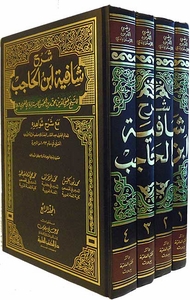
A modern printing of the 4 vol. commentary on the al-Shāfiyya of Astarabadi.
[3] Ibn-i-Ḥājib = ابن الحاجب = Ibn Ḥājib, Jamāl al-Din Abu `Amr `Uthmān ibn `Umar ibn Abi Bakr al-Māliki (b. Asnā, Upper Egypt, after 570/1174-5 -d. Alexandria 26th Shawwāl 646/11th February 1249). An Egyptian Sunni grammarian of the Māliki school.
Ibn al-Ḥājib, al-Mālikī : Primary sources and select Bibliography
al-Shāfiyya ("the Satisfactory") + On sarf Arabic morphology. There is also a commentary on this work by its author.
al-Kāfiyya ("The Sufficient") - a very comprehensive considerastion of nahw Arabic syntax.on which numerous commentaries have been written.
- 1
- 2
- Amālī Ibn al-Ḥājib, on aspects of grammar, part one devoted to the Qurʾān, and part two to al-Zamakhsharī’s Mufaṣṣal.
al-Astarābādhī, Raḍī al-Dīn Muhammad ibn al-Ḥasan (d. 684/1285 or 686/1288).
- Sharḥ al-Kāfiyya,
- Sharḥ al-shāfiyya, a commentary on Ibn al-Ḥājib’s shāfiyya.
Select secondary sources on Ibn al-Ḥājib, al-Mālikī
H. Fleisch, Ibn al-Hādjib in EI2 Vol. V p. 781. EI2 = The Encyclopedia of Islam. 2nd edition. Leiden-London: E. J. Brill, 1960–2004. 12 vols.
♦
[4] Ibn-i Mālik = Ibn Mālik (c. 1203-1274 CE). .

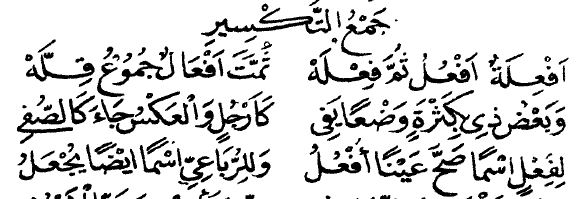
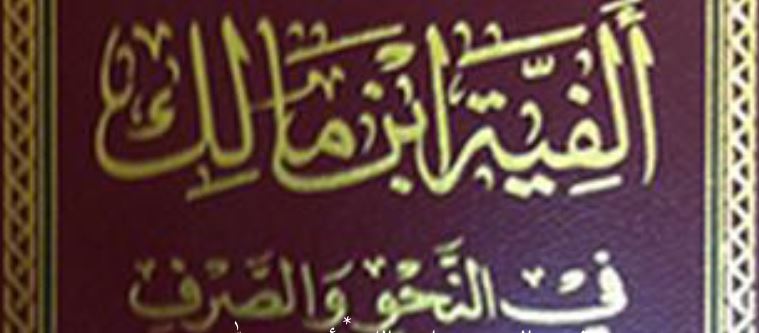
From a 19th cent, Lithograph and modern printing of the Alfiyya of Ibn Mālik on Grammar and Syntax.
Ibn-i-Mälik = Ibn Mālik, Muḥammad ibn ʻAbd Allāh al-Ṭāʾī al-Jayyānī (b. Jayyān [= Jaén] Andalusia, Spain c. 600 or 602 /c. 1203-5 - d. Damascus, 12th Sha`ban 672/22 February 1274).
A very influential and polymathic Māliki then Shā`fi'i Sunni Muslim grammarian.
On Abū ʻAbd Allāh Jamāl al-Dīn Muhammad Ibn Mālik see,
- al-Kāfiya fī l-naḥw. Beirut: Dār al-Kutub al-ʿIlmiyya, 1399/1979. 2 vols.
- al-Kāfiya fī l-naḥw”. In: al-Astarābādī, Raḍī al-Dīn Muhammad ibn al-Ḥasan.
- Sharḥ kāfiyat Ibn al-Ḥājib. ed. Imīl Badīʿ Yaʿqūb. Beirut: Dār al-Kutub al-ʿIlmiyya, 1419/1998. 5 vols.
- Sharḥ: Ibn al-Ḥājib, al-ʾĪḍāḥ fī sharḥ al-mufaṣṣal. ed. Mūsā Bannāy al-ʿAlīlī. Baghdad: Maṭbaʿat al-ʿĀnī, 1402/1982. 2 vols.
- ʾAmālī Ibn al-Ḥājib. Ed. Faxr Ṣāliḥ Sulaymān Qaddāra. Amman: Dār ʿAmmār, 1409/1989. 2 vols.
- Sharḥ al-kāfiyya. An important commentary on Ibn al-Ḥājib’s Kāfiyya
In his abovementioned EI2 article H. Fleisch writes that in matters grammatical Ibn Mālik had "earned an immense reputation" adding that "This he owed to his philological knowledge, which was certainly very great, but also in large measure to a fact which in itself remains of secondary importance, his versification of Arabic grammar in the Alfiyya; rhyme was indeed an aid to memorization in those Arab countries where learning by heart was the usual method of instruction; furthermore the verses of his Alfiyya, "always obscure and often unintelligible" (Howell, Ar. Gr., Preface XXVI), offered a choice of material to a host of commentators. Interest in grammar was revived." (so Fleisch EI2 V:800-801). EI2 = The Encyclopedia of Islam. 2nd edition. Leiden-London: E. J. Brill, 1960–2004. 12 vols.
-
Howell, Grammar = Howell, Mortimer Sloper. A grammar of the classical Arabic language, translated and compiled from the works of the most approved native or naturalized authorities. Allahabad: Government Press, 1880–1911. 4 vols.
Ibn Mālik, Muḥammad ibn ʻAbd Allāh al-Ṭāʾī al-Jayyānī : Primary sources and select Bibliography.
This work is "a treatise on grammar in 2757 verses (rajaz), according to Brockelmann (I2, 363), with a commentary by the author, al-Wāfiya, in manuscript" (EI2 ibid). It has been studied, memorized and commented upon by thousands of Muslims. Up till recent times it had been a fundamental part of Arabic Islamic education.

The al-Khulāsa al-Alfiyya .
The Alfiyya ("Thousand fold [verses]) is a versification of Arabic grammar.
This work of Ibn Malik is a resume of the above al-Khāfiyya al-shāfiya in about 1,000 verses.
The ألفية ابن مالك في النحو والصرف = Alfiyya Ibn Mālik fi al-nahw wa'l-sarf.
Ibn Mālik, Abū ʿAbdallāh Jamāl al-Dīn Muhammad b. ʿAbdallāh b. Mālik al-Ṭāʾī l-Jayyānī
Ibn Mālik / Silvestre de Sacy, Antoine-Isaac (1758-1839), an importnat French orientalist and for some the father of Arabic scholarship in Europe.
PDf downloads of Alfiyya from Archive. com and elsewhere:
See World Cat.
For further Commentaries on grammatical works of see World Cat. :
♦
- Encyclopedia of Islam 1st ed. vol. X pp. x-x art. `Ibn Mālik' by Ben Cheneb.
- EI2 (2nd ed. EI2 = The Encyclopedia of Islam. 2nd edition. Leiden-London: E. J. Brill, 1960–2004. 12 vols.) vol. V pp. 861-2 art, `Ibn Mālik' by H. Fleisch. Also, the Encyclopaedia of Islam CD-ROM Edition v. 1.0 © 1999 Koninklijke Brill NV, Leiden, The Netherlands. This important article contains a very useful annotated list of a dozen or so of Ibn Mālik's Arabic grammatical works.
- al-Khāfiyya al-shāfiya and the Alifiyya
- Alfiyya; ou, La quintessence de la grammaire arabe, ouvrage de Djémal-eddin Mohammed, connu sous le nom d'Ebn-Malec. Paris, London. Printed for the Oriental Translation Fund of Great Britain and Ireland, 1833. viii, 254 pages ; 143 pages 22 cm. Arabic original and French notes and comments by De Sacy. According to WorldCat. this book has gone through "10 editions published between 1888 and 1995 in 3 languages and held by 25 WorldCat member libraries worldwide".
- al-ʾAlfiyya. In: Goguyer, Antoine (ed.). Manuel pour l’étude des grammarians arabes. La `Alfiyyah d’Ibnu-Mālik. Beirut: Imprimerie des Belles-Lettres, 1888.
- https://archive.org/details/alfiyyaoulaquin00mlgoog
- https://archive.org/details/MatanAlfiyahIbnuMalik
- http://privat.bahnhof.se/wb449823/00_DATA/Kutub/Arabic-Language/Alfiyya_...
- https://worldcat.org/identities/lccn-n83-56178/
- http://www.worldcat.org/search?q=su%3AIbn+M%C4%81lik%2C+Mu%E1%B8%A5ammad...



